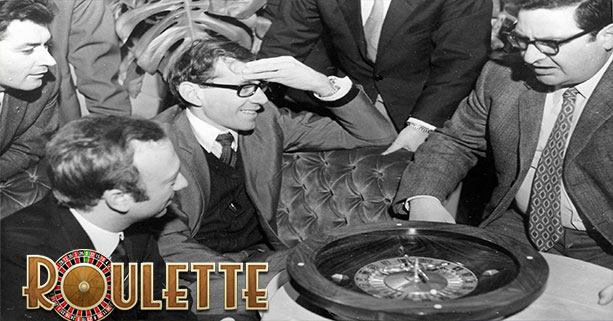Roulette is normally considered a completely random game. Your bet results are determined by where a ball lands on a rapidly spinning wheel. But a small percentage of players have figured out ways to beat roulette through skill. Dr. Richard Jarecki is one such player, because he won what amounts to $8 million today on the roulette tables.
Sadly, Dr. Jarecki recently passed away due to pneumonia. In memory of him, I want to discuss how he earned one of the biggest casino profits ever. Keep reading to find out who this legend is, his methods for beating roulette, and if you can replicate Jarecki’s strategy.
Who Is Dr. Richard Jarecki?
 Richard Jarecki was born in Stettin, Germany on December 1, 1931. His Jewish parents, Dr. Max and Gerda Jarecki, ultimately fled the country in the late 1930s after the rise of Nazi Germany. They settled in Asbury Park, New Jersey, where Richard would grow up and graduate from high school. He went on to study at Duke University and later earned his medical degree from the University of Heidelberg.A few years later, Jarecki met his future wife, Carol Fuhse, during a medical residency. The two got married in 1964 and moved to Germany in 1967. It’s here where Jarecki discovered his love of roulette. He and Carol began traveling to casinos all over Europe, including Sam Remo (Italy), Baden-Baden (Germany), Divonne-les-Bains (France), and Monte Carlo.
Richard Jarecki was born in Stettin, Germany on December 1, 1931. His Jewish parents, Dr. Max and Gerda Jarecki, ultimately fled the country in the late 1930s after the rise of Nazi Germany. They settled in Asbury Park, New Jersey, where Richard would grow up and graduate from high school. He went on to study at Duke University and later earned his medical degree from the University of Heidelberg.A few years later, Jarecki met his future wife, Carol Fuhse, during a medical residency. The two got married in 1964 and moved to Germany in 1967. It’s here where Jarecki discovered his love of roulette. He and Carol began traveling to casinos all over Europe, including Sam Remo (Italy), Baden-Baden (Germany), Divonne-les-Bains (France), and Monte Carlo.
The husband and wife both possessed mathematical minds and began contemplating advantage play in the late 1960s. Jarecki eventually realized that not all roulette wheels produce random results, thus making them susceptible.
Jarecki Figures Out the Key to Beating Roulette
Richard Jarecki developed the skills and knowhow to beat roulette on a consistent basis. He especially terrorized the San Remo casino, winning a massive fortune from them.
The goal is to figure out if a wheel is biased toward certain numbers. One also has to gather and crunch data to figure out which numbers/section the bias is occurring in. Jarecki recruited Carol and a few other people they knew to record the spins. They sometimes tracked up to 10,000 spins on a single wheel. This doesn’t sound so excruciating when considering the potential reward. But the bad thing about wheel bias is that it sometimes turns up nothing.
Carol and Richard discovered this the hard way as it sometimes took over a month to find a single biased wheel. But when they did find this gem, they’d exploit it for huge profits. Admittedly, the couple didn’t invent wheel bias. But they did take credit for perfecting the craft and getting maximum value out of their abilities.
The European Roulette Advantage
European roulette gave the Jareckis an advantage over American wheel bias masters. They particularly spent a lot of time gambling in Italy, which is filled with European tables. As you may know, a European wheel has 37 numbers and a single zero. When you divide the house-friendly zero pocket by the 37 total numbers, you arrive at a 2.70% house edge.
European gambling venues will eventually throw out advantage players. But they take longer to observe their play and make a final determination. US casinos, on the other hand, are quicker to rush to judgment. American venues don’t always even have enough evidence when they toss a potential advantage gambler.
This combination of lenient treatment and European wheels allowed Richard’s team to make a fortune through wheel bias. By the time they were done in the early 1970s, they’d earned over a $1.28 million profit, which is worth $8 million when adjusted for inflation.
Casinos Catch on to Jarecki’s Winning Ways
When you win seven figures from casinos, they start to become suspicious on how you’re winning. Such was the case with the Jareckis, who began drawing heat for their roulette success. Casinos responded by moving wheels around the floor to confuse Richard. They suspected that he’d been taking advantage of certain wheels and figured that this would thwart his success.
Richard wasn’t stopped by the moved wheels, though, because he’d memorized small imperfections and scratches in the biased wheels’ woodwork. Therefore, he was able to move around casinos and still spot the imperfect wheels.
It didn’t take long for Richard to appeal this decision and continue frequenting the San Remo casino. He famously told a newspaper at the time, “If casinos manages don’t like to lose, then they should sell vegetables.” The San Remo gambling establishment eventually solved their problem by replacing all of the floor’s roulette wheels. They also purchased better-built wheels to reduce the chances of Jarecki or anybody else beating them.
He never quite recaptured the glory of what he did in Europe. But it wasn’t like he needed the money when considering that he’d already won the equivalent of $8 million through roulette along with his trading profits.
How to Replicate Richard Jarecki’s Feat
Richard Jarecki didn’t use an advanced computer from the University of London as he told the media. Instead, he merely relied on wheel bias, which has been around since the 1870s.
Joseph Jagger, an English engineer, was the first confirmed story of somebody using wheel bias to beat roulette. Jagger visited Monte Carlo’s Beaux Arts Casino in 1873 and won what amounts to £7 million today.

Jarecki used the same technique almost a century later to win a huge fortune. But can you still use wheel bias to win roulette profits these days? The answer all depends upon what kind of wheels you’re able to find. Cheaply manufactured roulette wheels can break down over time and feature damaged frets (pocket dividers), off-balanced shafts, and/or uneven pockets.
You can’t spot these imperfections just by looking at the wheel. This is why it’s necessary to record a large range of spins and break down the data. The amount of spins that you need to record varies based on whether you’re trying to determine section or number bias.
Section bias is when the wheel favors a group of consecutive numbers. For example, a biased wheel might produce more wins in a wheel section including 4-21-2-25-17-34. You typically need to watch a wheel for at least 500 spins to find a biased section. It may take you 8-12 hours total to accomplish this.
Number bias is when the wheel leans towards specific pockets. This is more difficult to find, because you’re dealing with specific numbers rather than a larger section. The standard for finding biased numbers involves watching the wheel for around 5,000 spins. You’ll likely spend 80-120 hours doing so.
How Do Modern Casinos Stop Wheel Bias?
Casinos have had well over a century to figure out how to stop wheel bias. And they’ve done a pretty good job of doing so, especially within the past few decades.
Starburst wheels have played a large role in reducing the effectiveness of this advantage gambling technique. A Starburst wheel features shallower pockets and metal frets, which are less likely to wear down and cause bias.
These wheels came about in the early 1980s, when British casinos had police investigators looking into whether people were cheating their roulette games. The police found that gamblers were using wheel bias, which is completely legal.
Of course, casino staff members don’t sit around recording spins like an advantage gambler would. Instead, tables have an electronic board/computer that records winning numbers. You can see these electronic boards on display at many roulette tables. Each board features the last 10-20 results from a given wheel.
Amateur players often use these numbers to make bets based on trends. For instance, they might start betting on odd numbers if they see even numbers have won the last four odd/even wagers. But electronic boards — or at least the computers behind them — serve another purpose in collecting data for the casino. Gaming venues then use this data to catch biased wheel before gamblers do.
One more way that casinos stop wheel bias is through equipment inspections. You’ll commonly see staff members testing out roulette wheels when they’re down. The goal is to make sure that the frets, pockets, and wheel shaft are all working properly. Inspections can often spot problems and enable the casino to either fix a wheel or scrap it.
Wheel bias has steadily become more advanced through the years. Everything began with Jagger sending clerks to Monte Carlo to record spins, then analyzing the data himself manually.Jarecki claims to be the first man to beat roulette through the use of computers, but this was merely a front to conceal how he was really winning. Dr. Jarecki’s strategy that was very similar to Jagger’s, except he and his wife recorded the spins themselves.
Famed gambler Billy Walters and his”Computer Team” were really the first ones to use modern equipment to beat roulette wheels. They manually recorded spins and used PCs to crunch data and quickly find biased wheels. The Computer Team won $3.8 million before they were finally banned from every Atlantic City casino.
Garcia-Pelayo is another player who used a mixture of observing spins and computers to crunch data. He and his family won around €2 million before they finally stopped playing after getting kicked out of too many casinos. As you can see, Dr. Richard Jarecki definitely belongs among the biggest roulette legends of all time. He also has the largest reported roulette profit (adjusted for inflation) in terms of US dollars.
Unfortunately, it’s getting harder and harder to pull off the same feat as Jarecki and other legends. Most casinos now use Starburst wheels, which are far less susceptible to breaking down. Gambling establishments also use the electronic tracking and equipment inspections to spot the biased wheels before they can be exploited.
But this isn’t to say that it’s completely impossible to beat roulette with advantage play. I assume that there are still biased wheels in existence, especially at some of the smaller Caribbean casinos. That being said, you can always take your chances of becoming the next Richard Jarecki by looking for biased wheels.
-
I once knew a Roulette dealer who could spin a number about once in 5 or 6 spins-by releasing the ball at a spot on the wheel Pit bosses can be a problem!

 MENU
MENU











